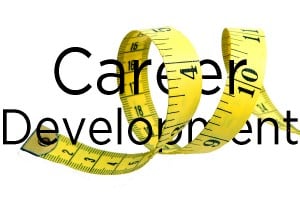Metrics and data are the name of the game today. Since what gets measured gets managed, organizations and the leaders running them are constantly searching for ways to quantify the impact of their initiatives and efforts. Some dimensions – like sales or customer service – are fairly easy to wrap numbers around. Others present real challenges. And career development is in this latter group.
 We know that career development – like eating vegetables – is good for us. Global data builds a case for it. But what about at an individual organizational level? How can anyone – from the CEO to a frontline supervisor – gauge the success of career development?
We know that career development – like eating vegetables – is good for us. Global data builds a case for it. But what about at an individual organizational level? How can anyone – from the CEO to a frontline supervisor – gauge the success of career development?
It is possible to evaluate the effectiveness of career development efforts through the use of lagging and leading indicators. Lagging indicators are things that change after career development improvements take place while leading indicators are those factors that change before career development follows that trend.
Non-Indicators
The problem is that too many organizations are skipping an exploration of either lagging or leading indicators. Instead they are choosing to study non-indicators. Too much emphasis is placed on a variety of administrative factors that have no relationship to real career development results:
- ‘People development’ as a core organizational value. Nearly every organization espouses a commitment to development. The walls of all executive office halls are covered with plaques (and frequently platitudes). But, putting it on paper doesn’t necessarily mean that you are putting it into practice.
- The number of development plans in the system. There is no correlation between physical plans and authentic development. In fact, many busy managers invest their limited time in completing the forms they’re accountable for… at the expense of engaging in authentic development.
- Documented IDP conversations. Managers are held accountable for having the conversation… but there’s no accountability for quality. As a result, these tend to be mechanical exchanges that in no way move the needle toward greater career results.
- Training rosters. It’s easy to think that if employees are being trained, then career development is happening. Not so! The bulk of development happens through experiences and activities on the job. Formal training is important, but only a small part of the overall development picture.
Lagging Indicators
A quick look in the rear-view mirror can reveal a lot about how career development is going in your organization.
- Employee opinion surveys and climate studies reveal a lot about how effectively your efforts are being received.
- Since there’s a clear link between career development, employee satisfaction and customer satisfaction, these metrics can be instructive.
- Retention and voluntary turnover statistics speak volumes about the extent to which your career development efforts are hitting the mark.
- Take a look at the ratio of internal versus external candidates placed in open positions. Organizations with a commitment to (and satisfaction around) career development will find that larger numbers of current employees are prepared to take on new roles.
- What do your bottom-line business results look like? There’s a direct connection between performance and career development.
- Who’s been promoted or moved? Creating a quick ‘family tree’ for each leader, indicating how employees have grown and transferred is a powerful visual of development in general – and a snapshot of those in your organization who are driving development results.
- What about innovation? How many new products or services are you launching? What kinds of improvements are in process? It’s those who are developing and growing who are likely delivering these sorts of results.
Leading Indicators for Career Development Success
Why wait to look backward at your efforts when you can explore real-time factors that will predict the trajectory of career development today? Leading indicators allow you to more proactively address this pressing priority.
- Follow the engagement. Deloitte, Right Management, and others have clearly identified a link between career development and engagement. As the needle moves on one, it generally moves on the other.
- Wellness factors might predict career development effectiveness as well. How is absenteeism trending? What are your safety or injury trends? These feed into the engagement-career development mix.
- And quality can suggest the direction of your career development. When errors are down and quality is up, you may find that career development success follows.
The indicators you choose depend upon your organization and the data that’s available, but choose something. What gets measured gets managed. And career development is clearly worthy of management.
What about you? How do you measure and predict career development success?
Image: Liz Price


Wow! Thank you so much for a very informative article! I am a Program Manager for a Learning & Career Center and I have been struggling with exactly what metrics to use to measure the success of career development for our adult students as we place them into jobs. Sometimes, things get so out of hand we end up “setting and forgetting” each student.
Thank you for providing a “launchpad” for me into career development success metrics!
Thanks for your comment, Claudine. It’s easy to let busy-ness crowd out the meaningful reflection and analysis that can positively affect our efforts. Best of luck to you!